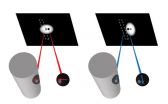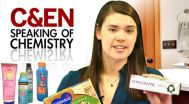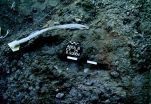Sharper nanoscopy
What happens when a quantum dot looks in a mirror?
2015-03-19
(Press-News.org) The 2014 chemistry Nobel Prize recognized important microscopy research that enabled greatly improved spatial resolution. This innovation, resulting in nanometer resolution, was made possible by making the source (the emitter) of the illumination quite small and by moving it quite close to the object being imaged. One problem with this approach is that in such proximity, the emitter and object can interact with each other, blurring the resulting image. Now, a new JQI study has shown how to sharpen nanoscale microscopy (nanoscopy) even more by better locating the exact position of the light source.
Diffraction limit
Traditional microscopy is limited by the diffraction of light around objects. That is, when a light wave from the source strikes the object, the wave will scatter somewhat. This scattering limits the spatial resolution of a conventional microscope to no better than about one-half the wavelength of the light being used. For visible light, diffraction limits the resolution to no be better than a few hundred nanometers.
How then, can microscopy using visible light attain a resolution down to several nanometers? By using tiny light sources that are no larger than a few nanometers in diameter. Examples of these types of light sources are fluorescent molecules, nanoparticles, and quantum dots. The JQI work uses quantum dots which are tiny crystals of a semiconductor material that can emit single photons of light. If such tiny light sources are close enough to the object meant to be mapped or imaged, nanometer-scale features can be resolved. This type of microscopy, called "Super-resolution imaging," surmounts the standard diffraction limit.
Image-dipole distortions
JQI fellow Edo Waks and his colleagues have performed nanoscopic mappings of the electromagnetic field profile around silver nano-wires by positioning quantum dots (the emitter) nearby. (Previous work summarized at http://jqi.umd.edu/news/using-single-quantum-dots-probe-nanowires). They discovered that sub-wavelength imaging suffered from a fundamental problem, namely that an "image dipole" induced in the surface of the nanowire was distorting knowledge of the quantum dot's true position. This uncertainty in the position of the quantum dot translates directly into a distortion of the electromagnetic field measurement of the object.
The distortion results from the fact that an electric charge positioned near a metallic surface will produce just such an electric field as if a ghostly negative charge were located as far beneath the surface as the original charge is above it. This is analogous to the image you see when looking at yourself in a mirror; the mirror object appears to be as far behind the mirror as you are in front. The quantum dot does not have a net electrical charge but it does have a net electrical dipole, a slight displacement of positive and negative charge within the dot.
Thus when the dot approaches the wire, the wire develops an "image" electrical dipole whose emission can interfere with the dot's own emission. Since the measured light from the dot is the substance of the imaging process, the presence of light coming from the "image dipole" can interfere with light coming directly from the dot. This distorts the perceived position of the dot by an amount which is 10 times higher than the expected spatial accuracy of the imaging technique (as if the nanowire were acting as a sort of funhouse mirror).
The JQI experiment successfully measured the image-dipole effect and properly showed that it can be corrected under appropriate circumstances. The resulting work provides a more accurate map of the electromagnetic fields surrounding the nanowire.
The JQI scientists published their results in the journal Nature Communications.
Lead author Chad Ropp (now a postdoctoral fellow at the University of California, Berkeley) says that the main goal of the experiment was to produce better super-resolution imaging: "Any time you use a nanoscale emitter to perform super-resolution imaging near a metal or high-dielectric structure image-dipole effects can cause errors. Because these effects can distort the measurement of the nano-emitter's position they are important to consider for any type of super-resolved imaging that performs spatial mapping."
"Historically scientists have assumed negligible errors in the accuracy of super-resolved imaging," says Ropp. "What we are showing here is that there are indeed substantial inaccuracies and we describe a procedure on how to correct for them."
INFORMATION:
Reference report: "Nanoscale probing of image dipole interactions in a metallic nanostructure," Chad Ropp, Zachary Cummins, Sanghee Nah, John T. Fourkas, Benjamin Shapiro, Edo Waks, Nature Communications, 19 March 2015; Doi:10.1038/ncomms7558
http://www.nature.com/ncomms/2015/150319/ncomms7558/full/ncomms7558.html
[Attachments] See images for this press release:

ELSE PRESS RELEASES FROM THIS DATE:
2015-03-19
Sifting through the center of the Milky Way galaxy, astronomers have made the first direct observations - using an infrared telescope aboard a modified Boeing 747 - of cosmic building-block dust resulting from an ancient supernova.
"Dust itself is very important because it's the stuff that forms stars and planets, like the sun and Earth, respectively, so to know where it comes from is an important question," said lead author Ryan Lau, Cornell postdoctoral associate for astronomy, in research published March 19 in Science Express. "Our work strongly reinforces the theory ...
2015-03-19
Researchers from Banner Alzheimer's Institute (BAI) have developed a new brain image analysis method to better track the progression of beta-amyloid plaque deposition, a characteristic brain abnormality in Alzheimer's disease, according to a study published in the March issue of the Journal of Nuclear Medicine. Investigators also believe this new approach may make it easier to evaluate investigational anti-amyloid treatments in clinical trials.
During the last decade, researchers have been using positron emission topography (PET) to assess amyloid plaque deposition in ...
2015-03-19
A psychology study from The University of Texas at Austin sheds new light on today's standards of beauty, attributing modern men's preferences for women with a curvy backside to prehistoric influences.
The study, published online in Evolution and Human Behavior, investigated men's mate preference for women with a "theoretically optimal angle of lumbar curvature," a 45.5 degree curve from back to buttocks allowing ancestral women to better support, provide for, and carry out multiple pregnancies.
"What's fascinating about this research is that it is yet another scientific ...
2015-03-19
WASHINGTON, March 19, 2015 -- It's a simple claim made on thousands of personal care products for adults and kids: hypoallergenic. But what does that actually mean? Turns out, it can mean whatever manufacturers want it to mean, and that can leave you feeling itchy. Speaking of Chemistry is back this week with Sophia Cai explaining why "hypoallergenic" isn't really a thing. Check it out here: http://youtu.be/lXh8bnqMOZs.
Speaking of Chemistry is a production of Chemical & Engineering News, a weekly magazine of the American Chemical Society. The program features fascinating, ...
2015-03-19
The Canadian research community on high-temperature superconductivity continues to lead this exciting scientific field with groundbreaking results coming hot on the heels of big theoretical questions.
The latest breakthrough, which will be published March 20 in Science, answers a key question on the microscopic electronic structure of cuprate superconductors, the most celebrated material family in our quest for true room-temperature superconductivity.
This result is the product of a longstanding close collaboration between the University of British Columbia Quantum ...
2015-03-19
Some 2.5 million years ago, early humans survived on a paltry diet of plants. As the human brain expanded, however, it required more substantial nourishment - namely fat and meat - to sustain it. This drove prehistoric man, who lacked the requisite claws and sharp teeth of carnivores, to develop the skills and tools necessary to hunt animals and butcher fat and meat from large carcasses.
Among elephant remains some 500,000 years old at a Lower Paleolithic site in Revadim, Israel, Prof. Ran Barkai and his graduate students Natasha Solodenko and Andrea Zupanchich of Tel ...
2015-03-19
DENVER, March 23, 2015 -- Since HIV emerged in the '80s, drug "cocktails" transformed the deadly disease into a manageable one. But the virus is adept at developing resistance to drugs, and treatment regimens require tweaking that can be costly. Now scientists at the 249th National Meeting & Exposition of the American Chemical Society (ACS) are announcing new progress toward affordable drugs that could potentially thwart the virus's ability to resist them.
ACS, the world's largest scientific society, is holding the meeting here through Thursday. It features nearly 11,000 ...
2015-03-19
Washington, D.C.--To combat global climate change caused by greenhouse gases, alternative energy sources and other types of environmental recourse actions are needed. There are a variety of proposals that involve using vertical ocean pipes to move seawater to the surface from the depths in order to reap different potential climate benefits. A new study from a group of Carnegie scientists determines that these types of pipes could actually increase global warming quite drastically. It is published in Environmental Research Letters.
One proposed strategy--called Ocean ...
2015-03-19
What if there were a pill that made you more compassionate and more likely to give spare change to someone less fortunate? UC Berkeley scientists have taken a big step in that direction.
A new study by UC Berkeley and UC San Francisco researchers finds that giving a drug that changes the neurochemical balance in the prefrontal cortex of the brain causes a greater willingness to engage in prosocial behaviors, such as ensuring that resources are divided more equally.
The researchers also say that future research may lead to a better understanding of the interaction between ...
2015-03-19
URBANA, Ill. - Over the last several decades there have been substantial yield improvements in soybean. Because of new varieties and new agronomic practices, the yield potential in soybean is higher now than ever before. But a lack of updated information on the nutritional needs of soybean crops may be limiting the crop's potential.
Researchers from the University of Illinois Crop Physiology Laboratory led by Fred Below have recently provided an updated set of nutrition needs for soybean, identifying exactly which nutrients the plant needs, when those nutrients are accumulated ...
LAST 30 PRESS RELEASES:
[Press-News.org] Sharper nanoscopy
What happens when a quantum dot looks in a mirror?



